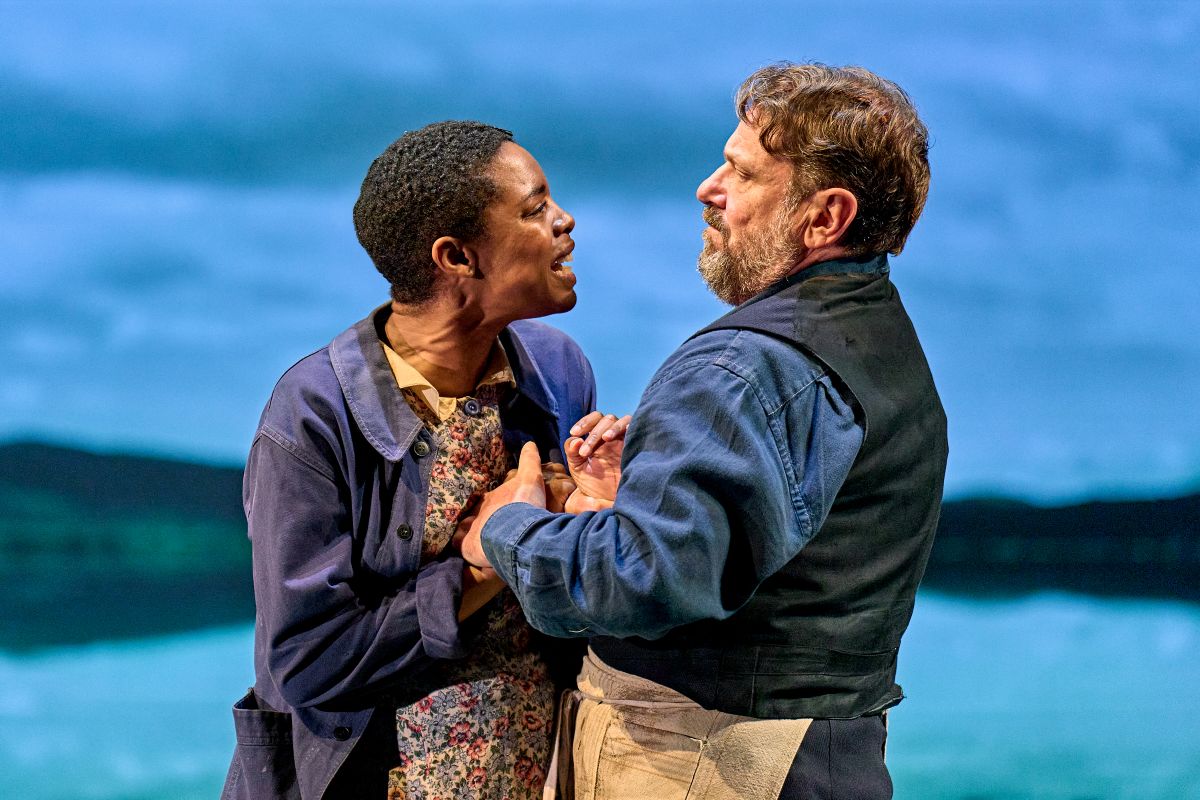Girl from the North Country redefines what musical theatre can be. It’s such a smashing idea that the only surprise is why no-one thought of it before.: Songs by one of the foremost songwriter/poets in the English speaking world and book by one of theatre’s grand-masters. As far as innovative musicals are concerned, Sondheim pulls it off but he’s not as great a poet as Dylan. Some modern musicals pull it off- popular, gorgeous songs, but they’re bound to the story of an individual artist’s life.
Instead of telling Dylan’s life, McPherson was inspired to write a story, a sprawling story set in an American guest house, about – what else, but the failure of the great American Dream. Dylan’s songs are not a backdrop to the story – they are an integral way of telling the story. It’s often said (by strange folk – and there is, as the saying goes, nothing stranger than folk) that plays (after the death of soliloquies) cannot get into the heads of characters in the way novels can. These songs, deep, evocative, are then, the play’s soliloquies.
The story is set in the post Crash (1929) years. The world is, yet again, broken. This is the story of an ordinary – enough – family trying to get along, to push along, to press on, to live when the living’s not easy. Mr Laine runs a boarding house. His wife is on the brink of dementia – but has strange moments of clarity. She’s one of those old women for whom old age has been freeing. She says the unsayable. From the precipice of where she stands, there can be no consequences – of any significance. Nick, the Laine’s son, is a writer and as a writer, is a dosser, a person not fit for the mechanics of this world. Marianne is the Laine’s daughter. She was left, as a baby, on their doorstep, in a basket, Moses like. She’s the black girl in a white family at a time and place where the Klu Klux Klan are rampant. Mr Laine is having an affair with one of the guests, Mrs Nielssen, a widow, who hopes to come into some money. Mr Burke and Mrs Burke, also guests, have what we would today call a severely autistic child, who is a young man. Marianne is pregnant, though the doctor/narrator seems to think it is a phantom baby. Mr Laine, aware of his own dire circumstances (loans not paid up), is trying to set his house in order. He wants Nick to take a regular job and he wants Marianne to marry an old man so that she doesn’t end up, with her baby, on the streets. Into the guest-house come two strangers: a boxer and a Bible salesman. That’s sufficient happenings to brew up a storm of a drama.
Elements of the story, though, felt too familiar. The Elias (Mr and Mrs Burke’s autistic grown up son) story reminds me of Steinbeck’s Of Mice and Men and McDonagh’s Pillowman. The boxer who may have killed a man and is therefore, loath to fight, reminds me of Huston’s, The Quiet Man; the boarding house set up reminds me of Rattigan’s Separate Tables and the whole American Dream debacle reminds me of the writer who indelibly stamped his name on that idea: Arthur Miller. But this is not to deny McPherson’s artistry. He knows how to pull in the laughs and he knows how to tip an audience to breaking point. And tenderness, he does with a fine fine touch. The relationships between mother and daughter is softly wrought, as is the relationship between Marianne and Joe and that between Nick and Kate. The old man who would be Marianne’s suitor is the one caricature in the mix, but maybe that’s what he’s meant to be.
The staging of the songs is beautiful: musicians to the left, just visible; ensemble singers often behind a screen or in shadow, tapping, clapping, singing along. There’s a gorgeous frame when everyone is at the piano. As a shot , it looks like a strangely densely populated Hopper painting, though there is more leaning in here, rather than Hopper’s fragilely held straight backs.

The ending sat heavy with me: The use of Christological images, the Mary, Joseph narrative. Of course, evangelical Christianity is a huge American theme and one cannot but be aware of Dylan’s foray into Christianity. Nevertheless, this element of the story, poised as it is at the end, felt, to me, at least, dramatically imposed.
Sweeping statement warning: The singing aside, most modern musicals have forgettable songs. Back in the 40s and 50s, in the heyday of Broadway musicals, the stories, the music and songs and singing were at their apex. But ‘Girl from the North Country’ has something different: Songs by one of the leading poets in the world (the man’s even got a noble Prize in Literature, if proof were needed, which it isn’t). If this production brings a new audience to Dylan, its’ more than done it’s job.
Written and directed by Conor McPherson
Songs by Bob Dylan
Musical Director/Piano/Harmonium: Alan Berry
Cast includes Katie Brayben, Colin Connor, Justina Kehinde, Maria Omakinwa, Sifiso Mazibuko, Eugene McCoy, Chris McHallem, Steffan Harri, David Ganly, Rebecca Thornhill, Colin Bates
Running Time: two hours 30 minutes, including a 20-minute interval
Until: 23 August 2025
Photo credit: Manuel Harlan

